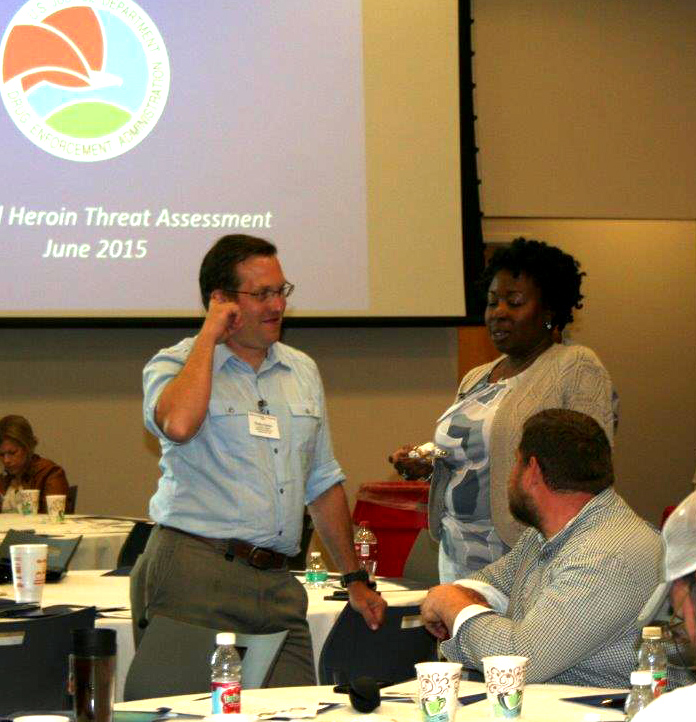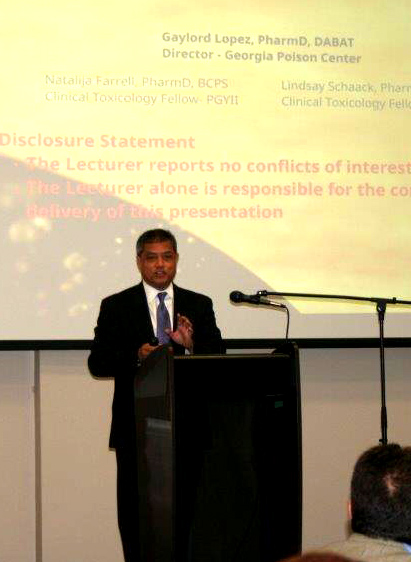Atlanta Summit on Exploding Heroin Abuse and Overdose Deaths in Georgia
On June 10, 2015, approximately 180 medical providers, policymakers, educators, substance abuse treatment providers, and law enforcement officers heard from a wide variety of experts and community representatives during a full day summit on the exponential growth of heroin trafficking and addiction in the Atlanta region. The U.S. Attorney’s Office for the Northern District of Georgia, the Atlanta Police Department, the Atlanta-Carolinas HIDTA, Drug Enforcement Administration, the Office of National Drug Control Policy, and the Georgia Bureau of Investigation jointly hosted the summit at Atlanta Metropolitan State College.
Key speakers from drug enforcement, public policy, health and medicine, and substance abuse treatment explored the scope of the heroin problem and steps that can be taken to address the problem. The summit included national and local law enforcement experts who are fighting the surge in heroin abuse, public health officials who are tracking and studying these trends, and substance abuse specialists, and a mother who told the heartbreaking story of the death of her son by a heroin overdose.

Acting U.S. Attorney John Horn told the group, “For some areas of the country, heroin abuse is the single largest public health issue, and these startling trends have unfortunately come to Georgia. The same factors and causes that have led to the crises in New England and the Midwest are found here, and deaths from heroin overdoses are multiplying both in the city as well as the suburban counties. Steps must be taken now to head off this trend before heroin becomes our biggest issue, because the effects on the communities where this has happened are truly devastating.”
"Heroin deaths have dramatically increased in Georgia over the last five years," sai Vernon Keenan, Director, Georgia Bureau of Investigation. "Today heroin users come from all backgrounds including the affluent and well educated. People who have become addicted to painkillers are finding heroin is easily accessible and inexpensive. It is important for people to understand how dangerous this drug is and to know what indicators to look for when they suspect someone may be using heroin."
“We are seeing unprecedented amounts of heroin moving into Georgia,” said Jack Killorin, director of the Atlanta-Carolinas High Intensity Drug Trafficking Area task force. “We’re seeing a growing user population, moving out of traditional market areas for heroin, moving throughout the state and into the suburbs, into the high schools. Much of this growth has been fueled by abuse of pharmaceuticals, including the illicit pill mills that distributed painkillers. As we have moved to shut down the pills mills, the markets for painkillers have been reduced, and addicts have filled that void with heroin.”
The summit’s opening speaker, Missy Owen of Marietta, Georgia, described the shock and hardships endured by her family upon discovering that her teenage son, Davis, was addicted to heroin. Davis Owen was an honors graduate from high school and athlete who tragically died from a heroin overdose. Missy Owen and her husband, Michael, started a foundation, the Davis Direction Foundation, dedicated to increasing public awareness of heroin abuse and the disease of addiction.
“This is a community problem,” Ms. Owen said. “There’s so much that we didn’t know about heroin and addiction. No family is immune, and this epidemic does not discriminate.”
The summit featured law enforcement briefings on heroin trafficking trends. On the national perspective, Kevin O’Brien, the section chief for strategic intelligence at DEA in Washington, explained that:
- Even using conservative statistics, heroin overdose deaths nationally have increased by 173% during the period of 2010 to 2013, and now more than 8,250 people die annually from heroin overdoses;
- People who abuse prescription drugs have increasingly substituted heroin for the prescription painkillers because the heroin doses are substantially cheaper and yield similar effects;
- Mexican drug trafficking cartels, which dominate the country’s illegal drug market, are increasingly transitioning to heroin, replanting marijuana fields in Mexico with opium to produce more potent, powder-form heroin to meet the growing demands in the United States;
- The increased availability of heroin in powder form has removed stigmas that traditionally limited heroin use, as the powder form can be inhaled or even ingested in pill form instead of requiring injection.
On the local front, Cobb County Deputy Chief Assistant District Attorney Jason Saliba described the increase in heroin trafficking and abuse seen in Atlanta’s northern suburbs. Saliba said that the region’s traditional source for heroin focused on neighborhoods on the west side of downtown Atlanta, but the Marietta-Cobb-Smyrna drug task force has noticed a shift in sourcing to the Mexican cartels.
“That has changed, and the source is now the Mexican cartels. The heroin is coming with all the other drugs across the Mexican border, and it’s absolutely killing us,” he said. He noted a second recent shift in local heroin trends, in that the bulk of defendants now are under age 35.
According to Nelly Miles, manager of the GBI’s drug testing lab which tests drug submissions by law enforcement officers across the state, the submissions involving heroin have skyrocketed in recent years. “Heroin is definitely the fast rising drug that we’re seeing,” she said. “Cocaine and methamphetamine are still the most popular, but the increase in heroin is disturbing.”

Dr. Gaylord Lopez, Director of the Georgia Poison Center, provided the attendees with a historical analysis of heroin use and a toxicological explanation of how heroin affects the body. Dr. Kris Sperry, Chief Medical Examiner for the State of Georgia, provided an overview of death statistics involving heroin and other illegal drugs. Dr. Sperry explained that deaths from overdoses of prescription drugs remains at epidemic levels throughout Georgia, but heroin deaths are growing--which he found to be notable in light of the fact that during the 1990s and 2000s, heroin was rarely encountered in Georgia drug fatalities.

In addition to heroin, speakers at the summit described the explosive growth in abuse of fentanyl, which is a synthetic opioid with substantially similar effects to heroin but is much more potent—and deadly. Dr. Sperry reported that, in the jurisdictions that report to his office, deaths involving fentanyl have spiked to where fentanyl is the fifth-most common drug in drug-related deaths. Overall, these jurisdictions reported 97 such deaths in 2014. And, according to Dr. Lopez, Grady Hospital in Atlanta conducted a three-week survey in May 2015 of urine drug screens, and found that a startling 11 percent of them revealed positive results for the presence of fentanyl.
Finally, Vince Caraffi, supervisor with the Cuyahoga County, Ohio, Board of Health, explained to summit attendees how Cleveland officials formed a regional task force to address epidemic-level heroin abuse and overdoses that plagued the city. Ohio experienced a surge in heroin deaths of 413% from 1999 to 2013, Caraffi said, so that annual heroin deaths in Ohio exceed those from prescription drugs, cocaine, and all other illegal drugs. In 2014, 195 people in Cuyahoga County died from heroin overdoses. Caraffi explained that, by bringing together lawmakers, public health officials, hospitals, educators, law enforcement, and parents, the Cuyahoga task force has stabilized the growth in heroin abuse to curtail the skyrocketing growth.
Acting U.S. Attorney John Horn announced at the summit the formation of an Atlanta regional task force to combat the growth in heroin trafficking and abuse, similar to the model employed in Cleveland, Ohio. During the summit, participants volunteered to join and assist the task force, which will hold its first meeting in July 2015.
In conjunction with the summit, the U.S. Attorney’s Office established a webpage to serve as a resource to the press and the public about heroin abuse. The webpage will include the presentation materials from the summit as well as other resources and links relating to heroin abuse. Additional materials will be added on a regular basis to update and expand the content on the website. The public is encouraged to visit the website.
For further information please contact the U.S. Attorney’s Public Affairs Office at USAGAN.PressEmails@usdoj.gov or (404) 581-6016. The Internet address for the home page for the U.S. Attorney’s Office for the Northern District of Georgia Gainesville Division is http://www.justice.gov/usao-ndga. The website for the Davis Direction Foundation is www.davisdirectionfoundation.org.

 U.S. Department
of Justice
U.S. Department
of Justice